Linking Hydrologic and Hydraulic Data with Models to Assess Flow and Channel Alteration at Hog Park, Wyoming USA
Abstract
1. Introduction
2. Study Site
3. Methodology
4. Results
5. Discussion
6. Conclusions
Author Contributions
Funding
Acknowledgments
Conflicts of Interest
Appendix A
| Event | Description | Location | Timing |
|---|---|---|---|
| Stage I of the Cheyenne—Little Snake River Project | Dam, reservoir, water collection system, and pipeline constructed and put into operation | Study Watershed | 1960s, full operation approx. 1965 |
| Stage II of the Cheyenne—Little Snake River Project | Dam, reservoir, water collection system, and pipeline enlarged and put into operation | Study Watershed | 1980s, full operation approx. 1987 |
| Measured Flow Records | Complete flow record available from CBPU and WSEO | Study Watershed Outlet | 1995–2005 |
| Measured Flow Records | USGS flow station moved to upstream of Hog Park Creek confluence | Reference Watershed Outlet | 1965–present |
| Measured Channel Geometry and Simulated Channel Hydraulics | Baseline survey, Repeated survey | Study Watershed Sensitive Reach | 2006, 2015 |
| Simulated Flow Records | Run-in period, evaluation period, and calibration period | Reference Watershed Outlet | 1987–1994, 1995–2004, 2005–2014 |
| Simulated Flow Records | Simulated natural flow record | Study Watershed Outlet | 1995–2015 |
Appendix B
| Calibration Data | Parameter | Value(s) |
|---|---|---|
| Average monthly SR | dday_intcp (Jan.–Dec.) | 9.964, 9.998, 9.968, −1.949, 2.165, −13.367, −32.135, −14.134, 4.305, 9.998, 9.07, 10 |
| tmax_index (Jan.–Dec.) | 66.473, 40.08, 101.567, 45.131, 62.531, 97.441, 92.825, 68.718, 107.316, 101.907, 100.899, 74.125 | |
| Basin average monthly ET | jh_coef (Jan.–Dec.) | 0.006, 0.019, 0.035, 0.012, 0.012, 0.01, 0.02, 0.054, 0.056, 0.021, 0.005, 0.005 |
| Average annual flow, Average monthly flow, and Monthly average flow | adjust_rain (Jan.–Dec.) | 0.831, 0.761, 0.199, 0.043, 0.998, 0.378, 0.005, 0.929, 0.155, 0.021, 0.893, 0.126 |
| adjust_snow (Jan.–Dec.) | 0.377, 0.997, 0.14, 0.006, 0.008, 0.009, 0.04, 0.452, 0.996, 0.004, 0.004, 0.002 | |
| Daily flow | adjmix_rain (Jan.–Dec.) | 2.922, 0.569, 0.63, 0.453, 1.663, 2.737, 2.033, 1.243, 0.807, 0.131, 0.993, 2.943 |
| cecn_coef (Jan.–Dec.) | 4.735, 9.653, 2.388, 0.076, 5.752, 9.531, 7.18, 8.745, 0.969, 0.884, 0.087, 8.196 | |
| emis_noppt | 1.000 | |
| free_h20cap | 0.110 | |
| potet_sublim | 0.154 | |
| slowcoef_lin | 0.003 | |
| slowcoef_sq | 0.004 | |
| snowinfil_max | 2.695 | |
| tmax_allrain (Jan.–Dec.) | 89.431, 65.778, 65.409, 52.916, 68.81, 81.706, 60.467, 68.192, 75.843, 82.594, 63.749, 85.035 | |
| tmax_allsnow | 34.403 | |
| Peak flow | smidx_coef | 0.005 |
| smidx_exp | 0.303 | |
| Low flow | gwflow_coef | 0.001 |
| soil2gw_max | 0.050 | |
| ssr2gw_exp | 0.005 | |
| ssr2gw_rate | 0.026 |
References
- Graf, W.L. Dam nation: A geographic census of American dams and their large-scale hydrologic impacts. Water Resour. Res. 1999, 35, 1305–1311. [Google Scholar] [CrossRef]
- Poff, N.L.; Allan, J.D.; Bain, M.B.; Karr, J.R.; Prestegaard, K.L.; Richter, B.D.; Sparks, R.E.; Stromberg, J.C. The natural flow regime. Bioscience 1997, 47, 769–784. [Google Scholar] [CrossRef]
- Williams, G.P.; Wolman, M.G. Downstream Effects of Dams on Alluvial Rivers; U.S. Geological Survey Professional Paper 1286; United States Goverment Printing Office: Washington, DC, USA, 1984.
- Andrews, E.D. Downstream effects of Flaming Gorge reservoir on the Green River, Colorado and Utah. Geol. Soc. Am. Bull. 1986, 97, 1012–1023. [Google Scholar] [CrossRef]
- Brandt, S.A. Classification of geomorphological effects downstream of dams. Catena 2000, 40, 375–401. [Google Scholar] [CrossRef]
- Gilliam, E.A. Assessing Channel Change and Bank Stability Downstream of a Dam, Wyoming. Master’s Thesis, Colorado State University, Fort Collins, CO, USA, 2011. [Google Scholar]
- Kellerhals, R.; Church, M.; Davies, L.B. Morphological effects of interbasin river diversions. Can. J. Civ. Eng. 1979, 6, 18–31. [Google Scholar] [CrossRef]
- Bradley, C.; Smith, D.G. Meandering channel response to altered flow regime: Milk River, Alberta and Montana. Water Resour. Res. 1984, 20, 1913–1920. [Google Scholar] [CrossRef]
- Petts, G.E.; Pratts, J.D. Channel changes following reservoir construction on a Lowland English River. Catena 1983, 10, 77–85. [Google Scholar] [CrossRef]
- Wohl, E.; Dust, D. Geomorphic response of a headwater channel to augmented flow. Geomorphology 2012, 138.1, 329–338. [Google Scholar] [CrossRef]
- Dominick, D.S.; O’Neill, M.P. Effects of flow augmentation on stream channel morphology and riparian vegetation: Upper Arkansas River basin, Colorado. Wetlands 1998, 18, 591–607. [Google Scholar] [CrossRef]
- Stromberg, J.C.; Patten, D.T. Response of Salix lasiolepis to augmented stream flows in the upper Owens River. Madrono 1992, 39, 224–235. [Google Scholar]
- Hrachowitz, M.; Savenije, H.H.G.; Blöschl, G.; McDonnell, J.J.; Sivapalan, M.; Pomeroy, J.W.; Arheimer, B.; Blume, T.; Clark, M.P.; Ehret, U.; et al. A decade of Predictions in Ungauged Basins (PUB)—A review. Hydrol. Sci. J. 2013, 58, 1198–1255. [Google Scholar] [CrossRef]
- England, J.F.; Cohn, T.A.; Faber, B.A.; Stedinger, J.R.; Thomas, W.O., Jr.; Veilleux, A.G.; Kiang, J.E.; Mason, R.R., Jr. Guidelines for determining flood flow frequency—Bulletin 17C (ver. 1.1, May 2019). US Geol. Surv. Tech. Methods 2018, 4(B5). [Google Scholar] [CrossRef]
- Miller, K.A. Peak-flow characteristics of Wyoming streams. Water Resour. Investig. Rep. 2003, 4107. [Google Scholar]
- Sanborn, S.C.; Bledsoe, B.P. Predicting Streamflow Regime Metrics for Ungauged Streams in Colorado, Washington, and Oregon. J. Hydrol. 2006, 325, 241–261. [Google Scholar] [CrossRef]
- Carlisle, D.M.; Falcone, J.; Wolock, D.M.; Meador, M.R.; Norris, R.H. Predicting the natural flow regime: Models for assessing hydrological alteration in streams. River Res. Appl. 2009, 26, 118–136. [Google Scholar] [CrossRef]
- Merz, R.; Blöschl, G. Regionalisation of catchment model parameters. J. Hydrol. 2004, 287, 95–123. [Google Scholar] [CrossRef]
- Chang, H.; Jung, I. Spatial and temporal changes in runoff caused by climate change in a complex large river basin in Oregon. J. Hydrol. 2010, 388, 186–207. [Google Scholar] [CrossRef]
- Maheshwari, B.L.; Walker, K.F.; McMahon, T.A. Effects of regulation on the flow regime of the River Murray, Australia. Regul. Rivers: Res. Manag. 1995, 10, 15–38. [Google Scholar] [CrossRef]
- Fassnacht, S.R. A multi-channel suspended sediment transport model for the Mackenzie Delta, NWT. J. Hydrol. 1997, 197, 128–145. [Google Scholar] [CrossRef]
- Parker, G.W.; Armstrong, D.S.; Richards, T.A. Comparison of Methods for Determining Streamflow Requirements for Aquatic Habitat Protection at Selected Sites on the Assabet and Charles Rivers, Eastern Massachusetts, 2000–02: U.S. Geological Survey Scientific Investigations Report 2004-5092, 72 p. 2004. Available online: https://pubs.usgs.gov/sir/2004/5092/ (accessed on 27 April 2020).
- Atwood, W.W. Records of Pleistocene Glaciers in the Medicine Bow and Park Ranges. J. Geol. 1937, 45-2, 113–140. [Google Scholar] [CrossRef]
- Houston, R.S.; Graff, P.J. Geologic Map of Precambrian rocks of the Sierra Madre, Carbon County, Wyoming, and Jackson and Routt Counties, Colorado. U.S. Geological Survey Miscellaneous Investigations Series Map I-2452; 1995; ISBN 978-0-607-79599-8. Available online: https://pubs.usgs.gov/imap/2452/report.pdf (accessed on 27 April 2020).
- NRCS National Water and Climate Center. Available online: https://www.wcc.nrcs.usda.gov/ (accessed on 26 November 2019).
- Clark, M.L.; Eddy-Miller, C.A.; Mast, M.A. Environmental Characteristics and Water-Quality of Hydrologic Benchmark Network Stations in the West-Central United States; U.S. Geological Survey Circular 1173-C; USGS: Reston, VA, USA, 2000; Volume 115.
- Leavesley, G.H.; Lichty, R.W.; Troutman, B.M.; Saindon, L.G. Precipitation—Runoff Modeling System: User’s Manual; US Geological Survey Water Resources Investigation Report 83-4238; USGS: Reston, VA, USA, 1983; Volume 207.
- Markstrom, S.L.; Regan, R.S.; Hay, L.E.; Viger, R.J.; Webb, R.M.T.; Payn, R.A.; LaFontaine, J.H. PRMS-IV, the Precipitation-Runoff Modeling System, Version 4; U.S. Geological Survey Techniques and Methods; USGS: Reston, VA, USA, 2015; Book 6, Chap. B7; 158p. [CrossRef]
- Brunner, G.W. HEC-RAS, River Analysis System User’s Manual; US Army Corps of Engineers Hydrologic Engineering Center: Davis, CA, USA, 2001.
- Wyoming State Engineer’s Office. Available online: http://seo.wyo.gov (accessed on 26 November 2019).
- USGS Water Data for the Nation. Available online: https://nwis.waterdata.usgs.gov (accessed on 26 November 2019).
- Hay, L.E.; Leavesley, G.H.; Clark, M.P.; Markstrom, S.L.; Viger, R.L.; Umemoto, M. Stepwise, multiple objective calibration of a hydrologic model for a snowmelt dominated basin. J. Am. Water Resour. Assoc. 2006, 42.4, 877–890. [Google Scholar] [CrossRef]
- Leaf, C.F.; Brink, G.E. Hydrologic Simulation Model of Colorado Subalpine Forest: U.S. Department of Agriculture; Forest Service Research Paper RM–107; USDA: Washington, DC, USA, 1973; Volume 23.
- Jensen, M.E.; Haise, H.R. Estimating evapotranspiration from solar radiation: Proceedings of the American Society of Civil Engineers. J. Irrig. Drain. 1963, 89, 15–41. [Google Scholar]
- Viger, R.J.; Leavesley, G.H. The GIS Weasel User’s Manual; U.S. Geological Survey Techniques and Methods; USGS: Reston, VA, USA, 2007; Volume 6.
- NREL National Solar Radiation Database Data Viewer. Available online: https://maps.nrel.gov/nsrdb-viewer/ (accessed on 26 November 2019).
- USGS Geo Data Portal. Available online: https://cida.usgs.gov/gdp/ (accessed on 26 November 2019).
- Nash, J.E.; Sutcliffe, J.V. River Flow Forecasting through Conceptual Model. Part 1—A Discussion of Principles. J. Hydrol. 1970, 10, 282–290. [Google Scholar] [CrossRef]
- Moriasi, D.N.; Arnold, J.G.; Van Liew, M.W.; Bingner, R.L.; Harmel, R.D.; Veith, T.L. Model evaluation guidelines for systematic quantification of accuracy in watershed simulations. Trans. Asabe 2007, 50, 885–900. [Google Scholar] [CrossRef]
- Limerinos, J.T. Determination of the Manning Coefficient from Measured Bed Roughness in Natural Channels. Studies of Flow in Alluvial Channels; U.S. Geological Survey Water-Supply Paper 1898-B; USGS: Reston, VA, USA, 1970.
- Arcement, G.J.; Schneider, V.R. Guide for Selecting Manning’s Roughness Coefficients for Natural Channels and Flood Plains; United States Geol. Survey Water Supply Paper 2339; USGS: Reston, VA, USA, 1989.
- Chow, V.T. Open-Channel Hydraulics; Mcgraw-Hill: Nez York, NY, USA, 1959. [Google Scholar]
- Richter, B.D.; Baumgartner, J.V.; Powell, J.; Braun, D.P. A method for assessing hydrologic alteration within ecosystems. Conserv. Biol. 1996, 10, 1163–1174. [Google Scholar] [CrossRef]
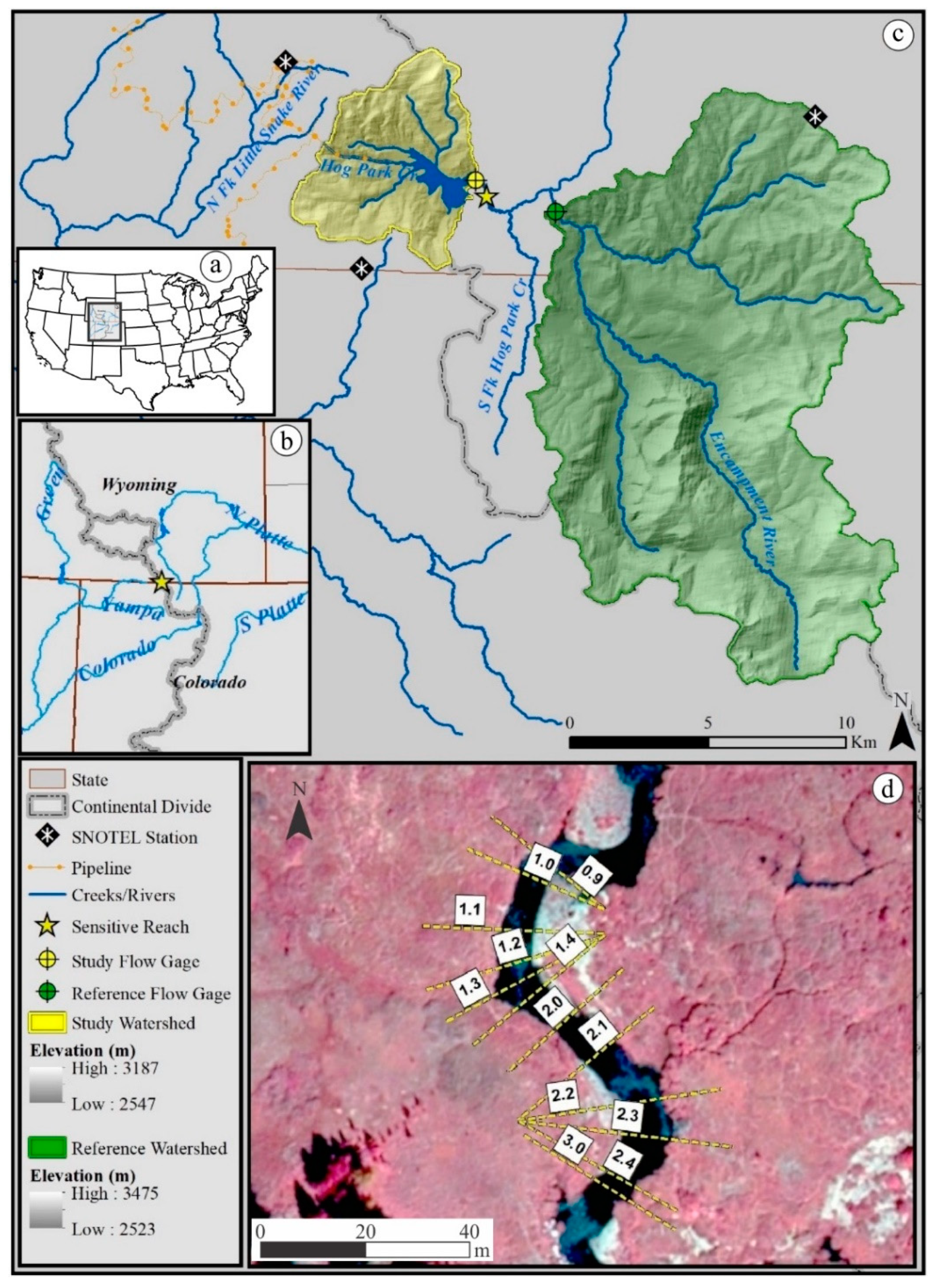
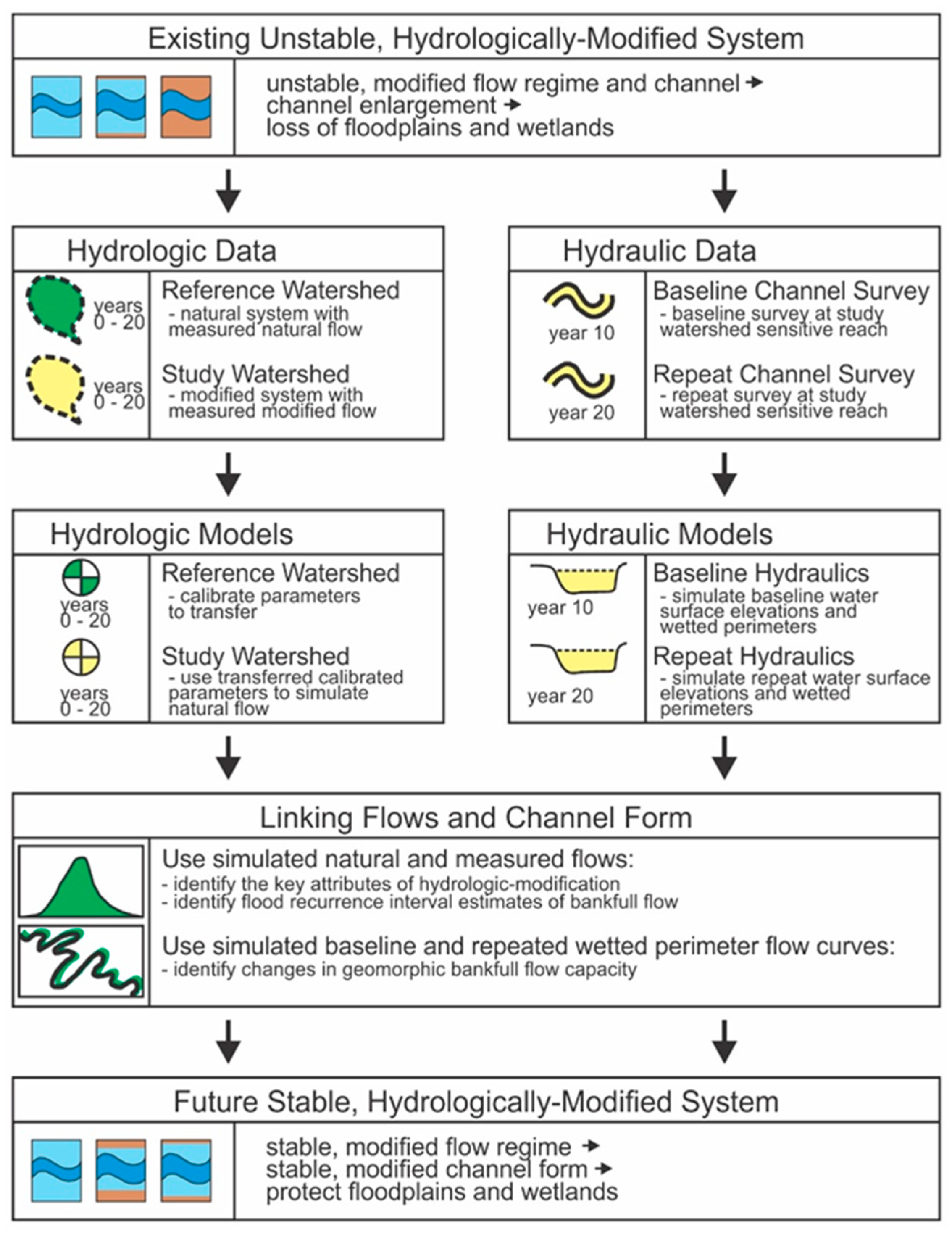
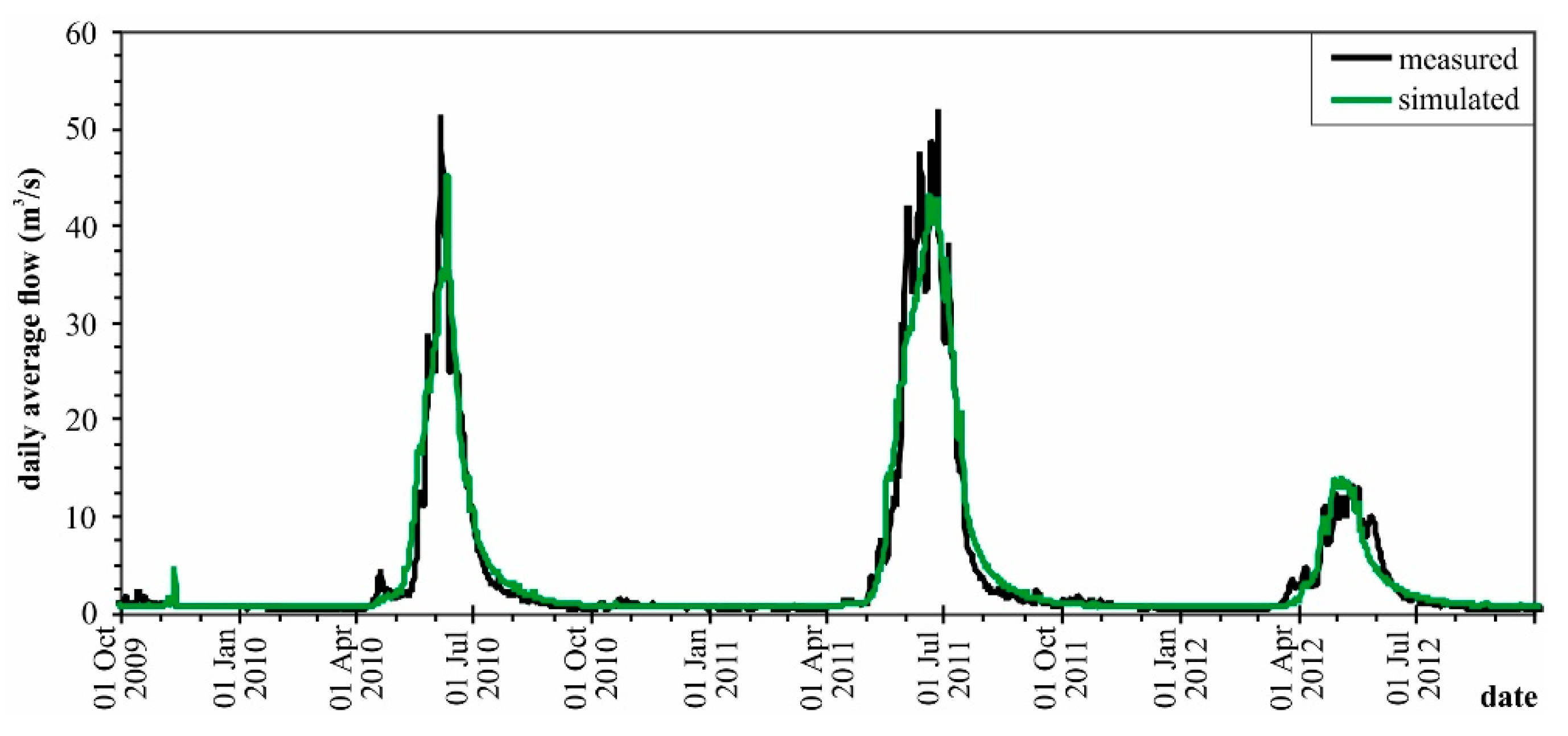
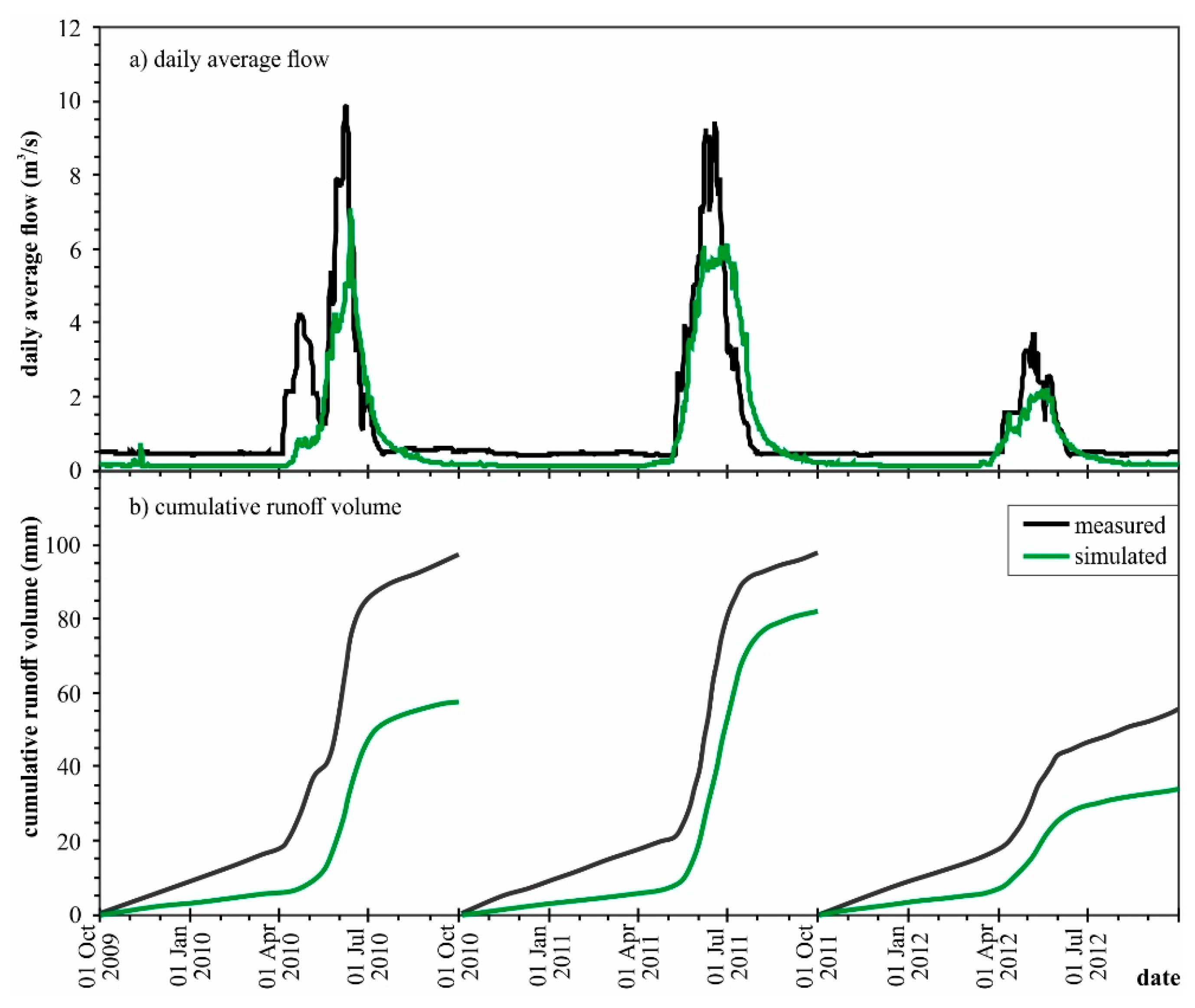
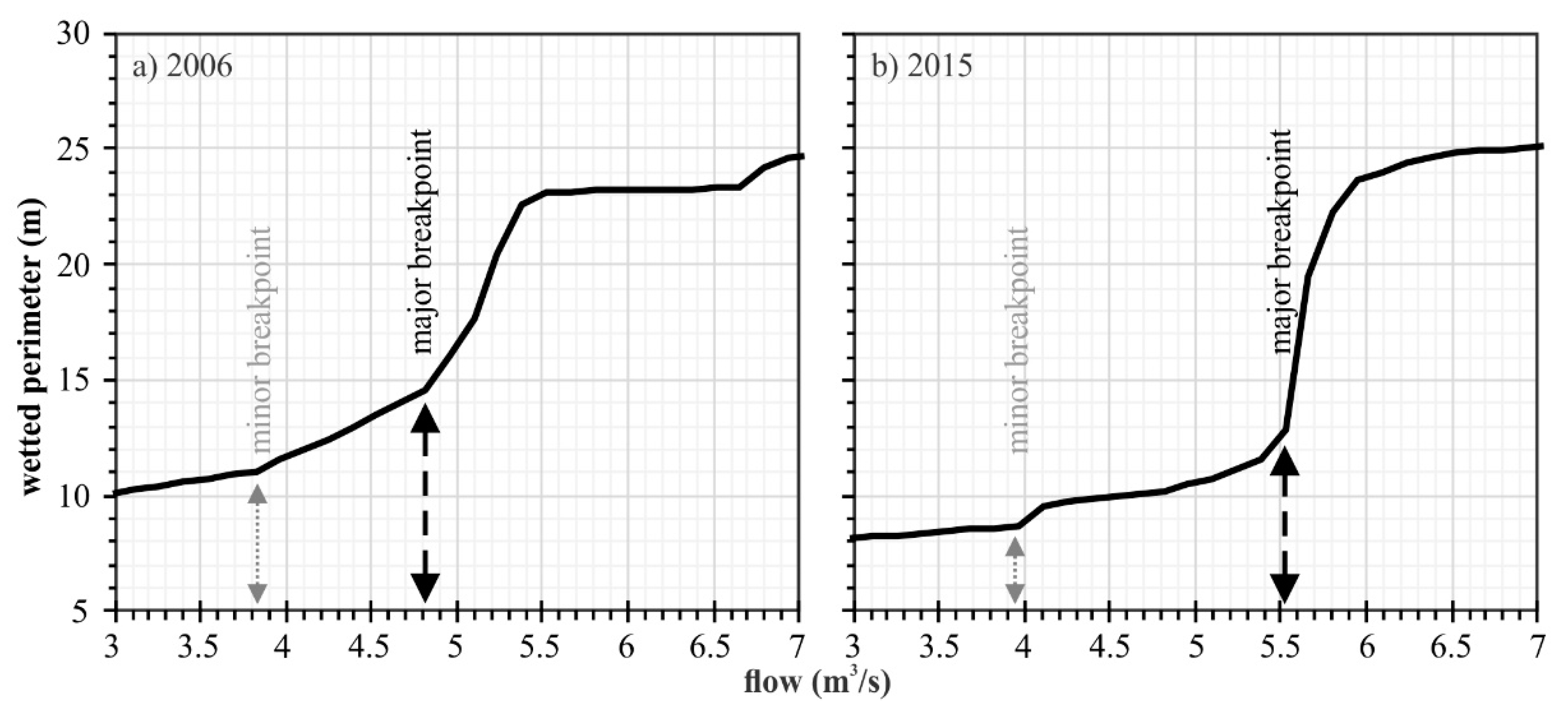
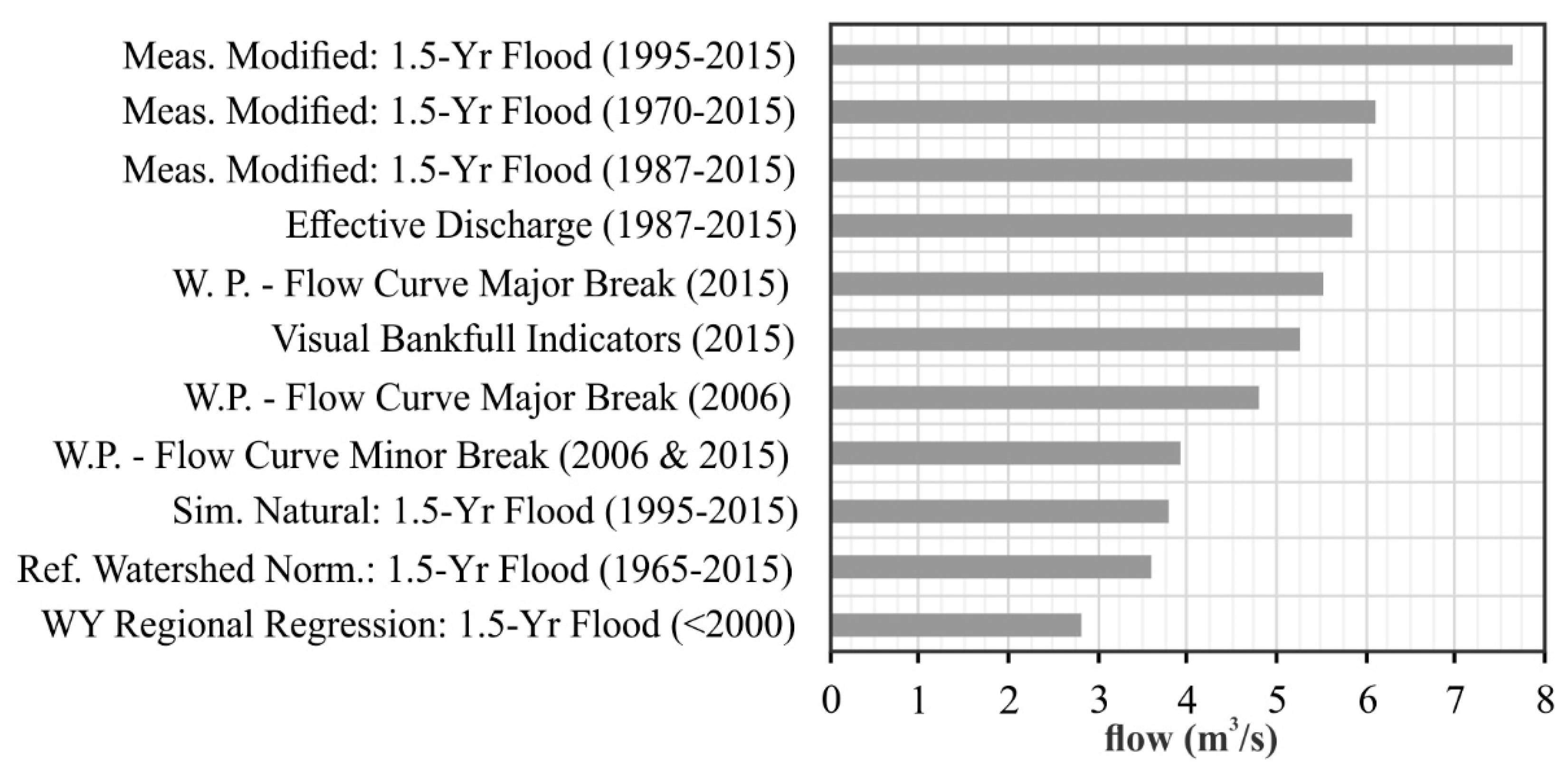
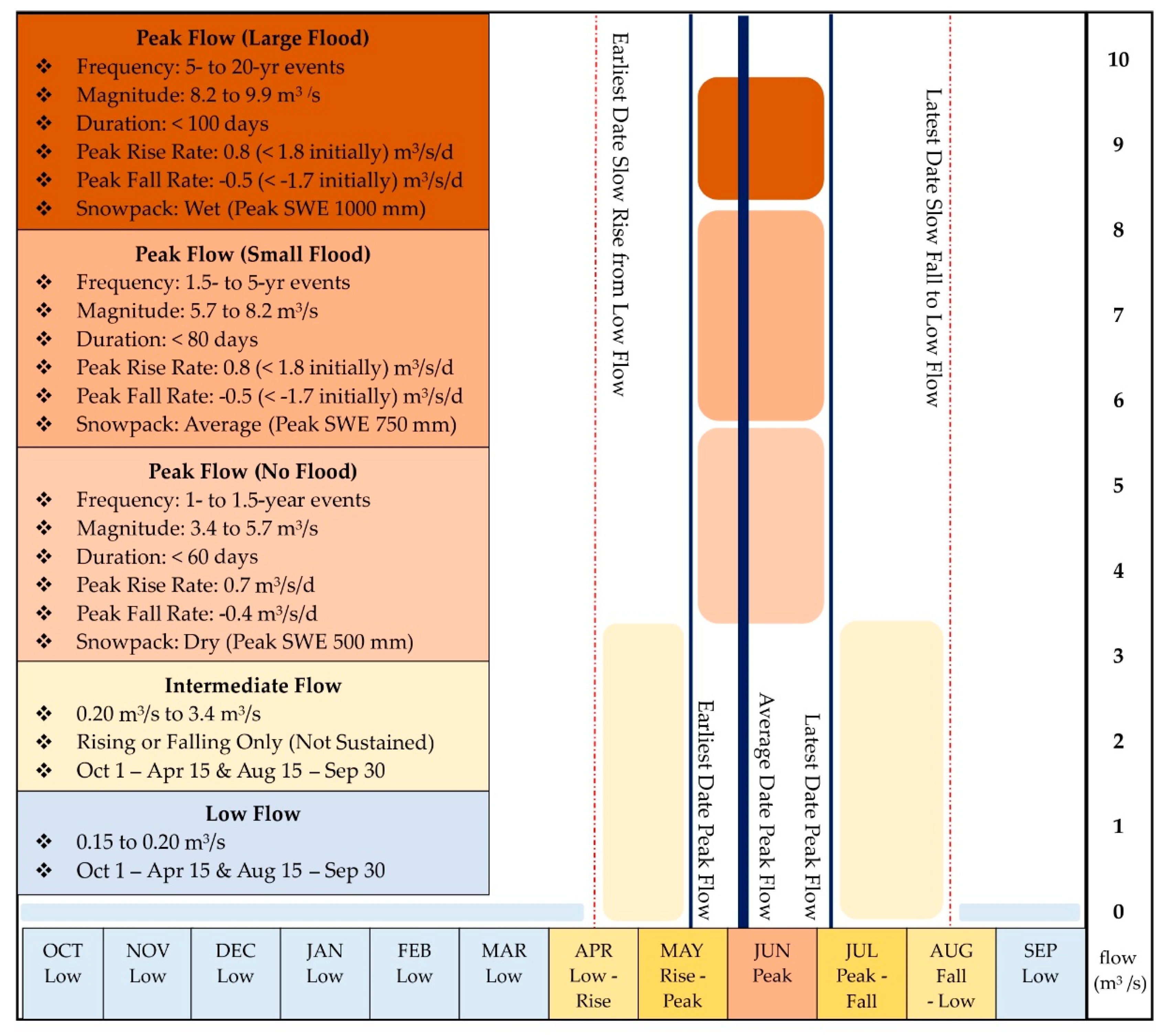
| Watershed Characteristic | Study Watershed | Reference Watershed |
|---|---|---|
| Drainage Area [km2] | 32 | 189 |
| Aspect (E, W, N, S) [%] | 33, 15, 21, 31 | 21, 32, 24, 23 |
| Elevation (Min, Max) [m] | 2550, 3200 | 2520, 3450 |
| Pinus contorta [%] | 40 | 26 |
| Picea engelmanii – Abies lasiocarpa [%] | 14 | 48 |
| Populus tremuloides [%] | 1 | 1 |
| Upland-, Wet- Shrub [%] | 0, 0 | 0, 1 |
| Wet-, Upland- Graminoid [%] | 1, 15 | 3, 10 |
| Forb [%] | 22 | 10 |
| Rock, Water [%] | 0, 7 | 1, 0 |
| Step | Calibration Data | Parameter | Parameter Description |
|---|---|---|---|
| 1 | Average monthly SR | dday_intcp | Intercept in T degree-day relationship |
| tmax_index | Index T used for P adjustments to SR | ||
| 2 | Basin average monthly ET | jh_coef | Coefficient used in the Jensen–Haise PET computations |
| 3 | Average annual flow, Average monthly flow, and Monthly average flow | adjust_rain | P adjustment factor for rain days |
| adjust_snow | P adjustment factor for snow days | ||
| 4 | Daily flow | adjmix_rain | Factor to adjust rain in mixed P events |
| cecn_coef | Convection condensation energy coefficient | ||
| emis_noppt | Emissivity of air on days without P | ||
| free_h20cap | Free water holding capacity of snowpack | ||
| potet_sublim | % PET sublimated from the snowpack surface | ||
| slowcoef_lin | Linear coefficient in the equation to route gravity-reservoir storage downslope | ||
| slowcoef_sq | Exponent in the equation to route gravity-reservoir storage downslope | ||
| snowinfil_max | Daily max. snowmelt infiltration for the hydrologic response units (HRU) | ||
| tmax_allrain | If a HRU max. T exceeds this value, P is rain | ||
| tmax_allsnow | If a HRU max. T is below this value, P is snow | ||
| 5 | Peak flow | smidx_coef | Coefficient in non-linear surface runoff contributing area algorithm |
| smidx_exp | Exponent in non-linear surface runoff contributing area algorithm | ||
| 6 | Low flow | gwflow_coef | GW routing coefficient |
| soil2gw_max | Max. rate of soil water excess moving to GW | ||
| ssr2gw_exp | Exponent to route water from the gravity-reservoir to groundwater (GW) | ||
| ssr2gw_rate | Linear coefficient to route water from the gravity-reservoir to GW |
| Flow Attribute | Meas. Modified Flow (Median) | Sim. Natural Flow (Median) | Deviation Factor | Significance (0 to 1) |
|---|---|---|---|---|
| Monthly Flow Attributes | ||||
| October (m3/s) | 0.48 | 0.17 | 1.9 | 0 |
| November (m3/s) | 0.48 | 0.15 | 2.1 | 0 |
| December (m3/s) | 0.47 | 0.15 | 2.2 | 0 |
| January (m3/s) | 0.47 | 0.14 | 2.3 | 0 |
| February (m3/s) | 0.50 | 0.14 | 2.5 | 0 |
| March (m3/s) | 0.51 | 0.14 | 2.7 | 0 |
| April (m3/s) | 1.13 | 0.35 | 2.2 | 0 |
| May (m3/s) | 3.22 | 1.95 | 0.7 | 0 |
| June (m3/s) | 3.35 | 3.10 | 0.1 | 0.7 |
| July (m3/s) | 0.52 | 0.66 | 0.2 | 0.3 |
| August (m3/s) | 0.49 | 0.30 | 0.6 | 0 |
| September (m3/s) | 0.47 | 0.20 | 1.4 | 0 |
| Annual Flow Attributes (water year from Oct. 1 to Sep. 30) | ||||
| 7-day Low (m3/s) | 0.44 | 0.13 | 2.3 | 0 |
| Annual Peak (m3/s) | 8.0 | 4.6 | 0.7 | 0 |
| Flood Attributes (the period from the start of the rising limb to the end of the falling limb) | ||||
| Peak (m3/s) | 8.0 | 5.1 | 0.5 | 0 |
| Duration (d) | 103 | 93 | 0.1 | 0.1 |
| Date of Peak | May 26 | June 6 | 0.1 | 0 |
| Rise Rate (m3/s/d) | 0.14 | 0.10 | 0.3 | 0 |
| Fall Rate (m3/s/d) | −0.16 | −0.09 | 0.7 | 0 |
| Recurrence Interval | Sim. Natural Flow (m3/s) | Percent Increase (%) | Meas. Modified Flow (m3/s) | Meas. Modified Flow (m3/s) | New, Stable, Modified Flow (m3/s) |
|---|---|---|---|---|---|
| 1995–2015 | - | 1995–2015 | 1987–2015 | 2025–2045 | |
| 1.1 | 2.26 | - | 3.68 | 4.53 | 3.4 |
| 1.5 | 3.77 | 67 | 7.62 | 5.83 | 5.7 |
| 2 | 4.59 | 22 | 7.96 | 7.59 | 6.8 |
| 5 | 5.58 | 22 | 9.26 | 9.03 | 8.2 |
| 20 | 6.91 | 22 | 10.73 | 10.22 | 9.9 |
© 2020 by the authors. Licensee MDPI, Basel, Switzerland. This article is an open access article distributed under the terms and conditions of the Creative Commons Attribution (CC BY) license (http://creativecommons.org/licenses/by/4.0/).
Share and Cite
Carleton, T.J.; Fassnacht, S.R. Linking Hydrologic and Hydraulic Data with Models to Assess Flow and Channel Alteration at Hog Park, Wyoming USA. Hydrology 2020, 7, 29. https://doi.org/10.3390/hydrology7020029
Carleton TJ, Fassnacht SR. Linking Hydrologic and Hydraulic Data with Models to Assess Flow and Channel Alteration at Hog Park, Wyoming USA. Hydrology. 2020; 7(2):29. https://doi.org/10.3390/hydrology7020029
Chicago/Turabian StyleCarleton, Tyler J., and Steven R. Fassnacht. 2020. "Linking Hydrologic and Hydraulic Data with Models to Assess Flow and Channel Alteration at Hog Park, Wyoming USA" Hydrology 7, no. 2: 29. https://doi.org/10.3390/hydrology7020029
APA StyleCarleton, T. J., & Fassnacht, S. R. (2020). Linking Hydrologic and Hydraulic Data with Models to Assess Flow and Channel Alteration at Hog Park, Wyoming USA. Hydrology, 7(2), 29. https://doi.org/10.3390/hydrology7020029






